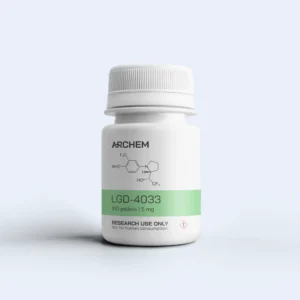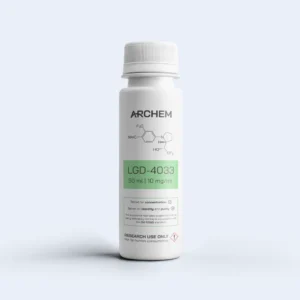Molecular Mingling: How LGD-4033 Works
Let’s go under the microscope first: LGD-4033 interacts with androgen receptors in a manner reminiscent of traditional anabolic steroids, but with a selective cunning. Where testosterone might barrel down the hormonal hallways and pound aggressively on every door—muscle, bone, and a variety of other tissues—LGD-4033 tends to be more of a polite, well-tailored guest. It carefully chooses which receptor doors to knock on, aiming primarily at skeletal muscle and bone cells. This targeted approach, at least in theory, offers a reduced risk of unwelcome side effects that often plague anabolic steroids, such as severe hormonal imbalances or glaring organ stress.
From a chemical standpoint, LGD-4033 is a nonsteroidal molecule, a younger cousin in the evolving SARM family tree. Its structure is a result of painstaking medicinal chemistry, where researchers shuffled molecular groups like puzzle pieces to craft a compound that binds specifically to androgen receptors in muscle and bone. It’s as though scientists took a blueprint of the human body’s anabolic pathways and said, “Let’s rewire this part, but keep the rest of the system intact.”
Early Chapters: History and Development
LGD-4033 was not hatched by alchemists in a medieval tower. Instead, it emerged from the laboratories of modern pharmaceutical companies like Ligand Pharmaceuticals, where chemists and pharmacologists toiled to create a compound to address muscle wasting conditions. Around the early 2010s, preliminary trials began to paint a picture of a compound that could increase lean muscle mass and improve bone density more gently than traditional anabolic steroids (see research data).
In those early studies, test subjects—often healthy men—demonstrated gains in lean mass with minimal serious side effects. Scientists beamed with cautious optimism, seeing in LGD-4033 a potential ally for patients struggling with age-related muscle loss or victims of degenerative muscle diseases. The clinical trials were baby steps toward a future where controlling muscle wasting might be as routine as managing cholesterol levels. Perhaps we could enhance healing from hip fractures, accelerate postoperative recovery, or help aging populations maintain their independence (NIH review).
Cultural Ripples and Under-the-Table Buzz
But as with many compounds that show athletic or muscle-enhancing promise, LGD-4033 has also found an audience beyond the medical community. Venture into internet forums devoted to bodybuilding, powerlifting, or the more clandestine corners of performance enhancement discussions, and you’ll hear whispers—some reverent, some skeptical—about Ligandrol’s ability to spur impressive strength gains.
In a world where superstars, athletes, and everyday gym-goers clamoring for the next best “edge” form a cultural tapestry, LGD-4033 easily slips into the narrative. It’s like the celebrity cameo in a blockbuster film, appearing unexpectedly, stirring excitement, and leaving just enough mystery to keep the audience guessing. Does it truly deliver near-steroidal gains without the steroid baggage? Cue the arguments, the anecdotes, the “bro-science” testimonies.
Regulatory authorities, as one might predict, have raised eyebrows. Doping agencies added LGD-4033 to their banned substance lists, and several high-profile athletes, once caught in the doping net, claimed ignorance—“I had no idea this was in my supplement!” Right. It’s a classic script where the line between medical research and athletic exploitation grows blurry, reflecting our cultural obsession with pushing human limits, consequences be damned.
Emotional Underpinnings: The Allure of the Perfect Body
Let’s face it—human beings have a complicated relationship with perfection. Whether it’s the quest to colonize Mars or simply to have a more defined bicep, we’re drawn toward betterment. LGD-4033 dangles a carrot in front of this innate drive. Who wouldn’t want a molecule that could sculpt their physique without the back-alley dealings and health risks of anabolic steroids?
Yet, as appealing as it might sound, emotions run deep here. Fear of unknown side effects, guilt over possible cheating in sports, the ethical quandaries of using such compounds for vanity—all these create a complex emotional current. We want to harness nature’s power, but we’re wary of paying a steep price. If this were a sci-fi narrative, LGD-4033 would be the alien technology: we know it could help us, but what unforeseen consequences lurk?
Real-World Implications: The Future of LGD-4033
We stand at a crossroads not just for LGD-4033, but for how we approach muscle chemistry as a whole. Will medical professionals one day prescribe SARMs UK like LGD-4033 to elderly patients to safeguard their mobility and independence? Could they become standard protocol in rehabilitation clinics, helping injured athletes return to the field faster and stronger?
Or will these compounds forever straddle the line between legitimate treatment and performance-enhancing temptation, locked in a chess game with regulatory bodies, doping authorities, and a perpetually curious public? The pharmaceutical industry, as well as scientific institutions, continue to probe safety, dosage, and the subtle interplay of these molecules with human physiology.








